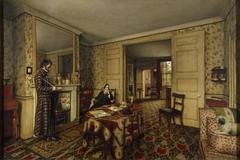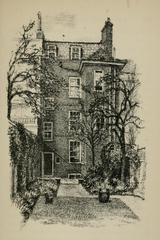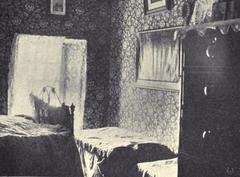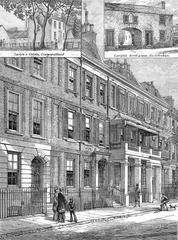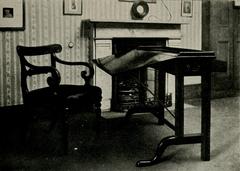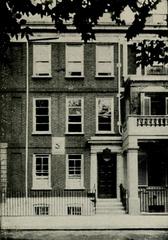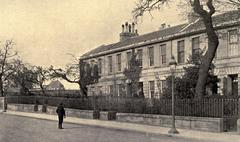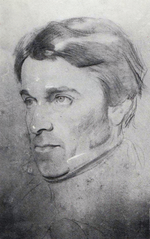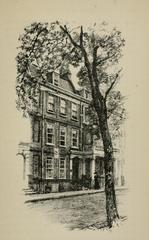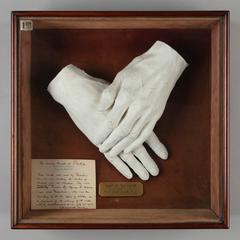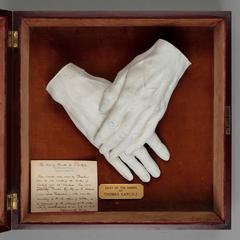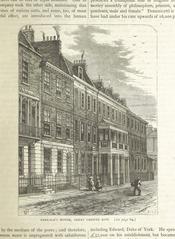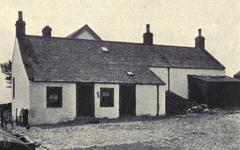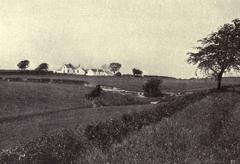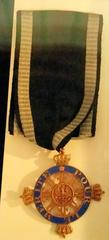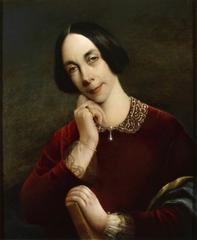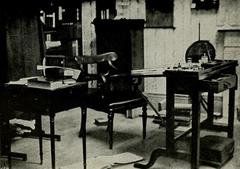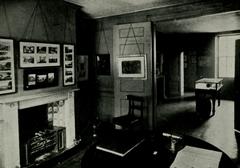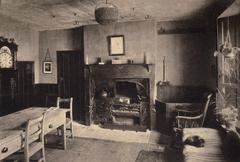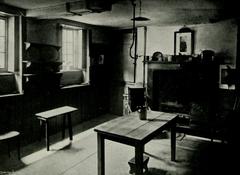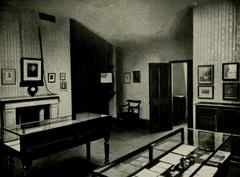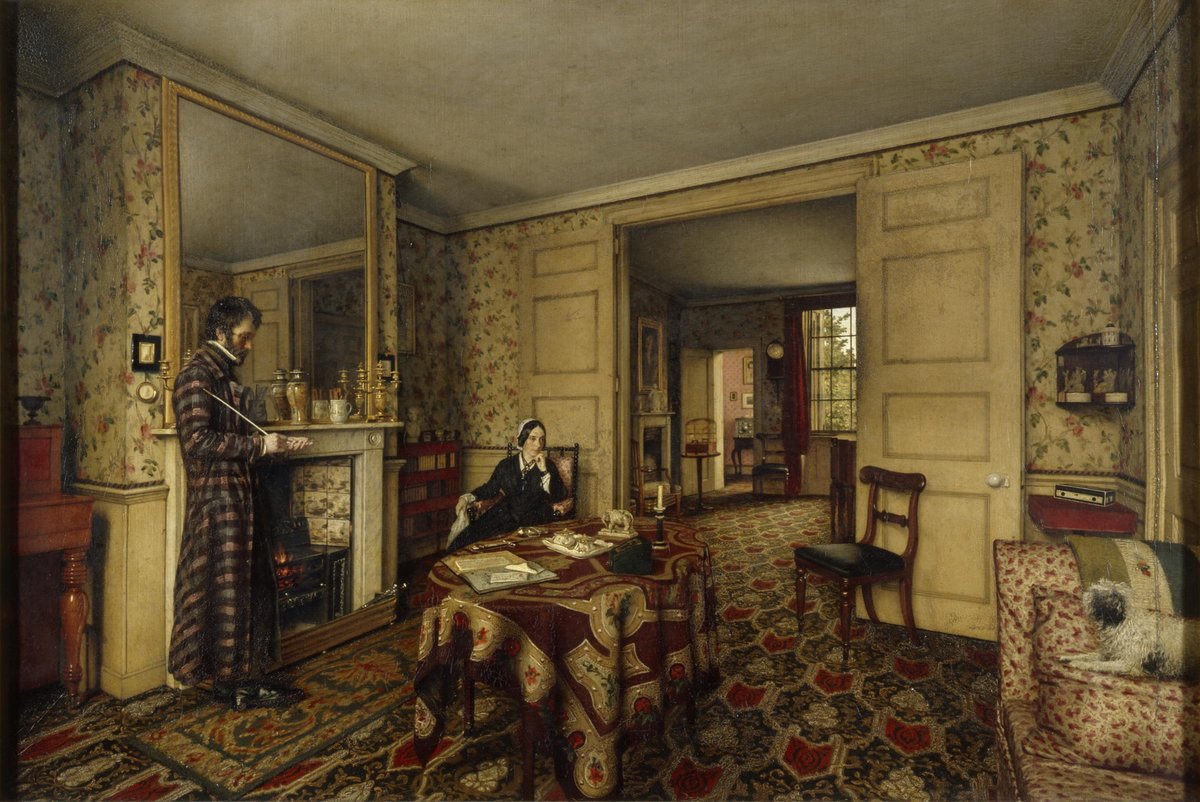
Carlyle’s House London: Visiting Hours, Tickets, and Historical Significance
Date: 14/06/2025
Introduction
Carlyle’s House, located at 24 Cheyne Row in Chelsea, London, stands as an enduring monument to Victorian literary and intellectual life. This Queen Anne townhouse, built in 1708, was home to the celebrated Scottish essayist and historian Thomas Carlyle and his wife, Jane Welsh Carlyle, from 1834 to 1881. Today, it is preserved by the National Trust and offers visitors a unique window into the world of 19th-century literature, thought, and domestic life. The house’s meticulously maintained interiors, authentic artifacts, and rich cultural heritage make it a must-see destination for history enthusiasts, literature lovers, and anyone interested in London’s storied past (Historic England; Museums London).
Historical Overview
Early Origins
Carlyle’s House is a fine example of early 18th-century domestic architecture, retaining its original brown-brick façade, sash windows, and period features. Though unassuming in appearance, it became a significant cultural site during the Victorian era when the Carlyles made it their home (Historic England).
The Carlyles’ Residency (1834–1881)
When Thomas and Jane Carlyle moved in, Chelsea was a tranquil suburb, ideal for the writer’s work. Their home soon became a vibrant literary salon, frequented by luminaries like Charles Dickens, John Stuart Mill, Alfred Lord Tennyson, and William Makepeace Thackeray (Britain Express; Museums London; Changing Pages). Carlyle’s soundproof attic study, built in 1853, was the birthplace of influential works such as The French Revolution and On Heroes, Hero-Worship, and the Heroic in History (Britain Express).
Preservation and Legacy
Following Carlyle’s death in 1881, the home was saved from redevelopment by public subscription and opened as a museum in 1895. The National Trust assumed stewardship in 1936, restoring the house to its mid-19th-century appearance, aided by contemporary paintings and detailed records. It was designated a Grade II* listed building in 1954, cementing its status as a heritage site (Wikipedia; Britain Express; Historic England).
Visitor Information
Opening Hours
- Wednesday to Sunday: 11:00 am – 5:00 pm (last entry 4:30 pm)
- Closed: Mondays, Tuesdays, and major public holidays
Always confirm current hours and any special closures on the National Trust website.
Tickets and Admission
- Adults: £10
- Concessions (students, seniors): Discounted rates
- Children under 16 and National Trust members: Free
- Booking: Purchase tickets online or at the door (advance booking recommended, especially during peak periods)
For up-to-date pricing and booking, visit the National Trust Carlyle’s House page.
Accessibility
Due to its historic layout, Carlyle’s House has limited accessibility. The ground floor and garden are partially accessible, but upper floors require navigating steep, narrow staircases. The National Trust provides detailed accessibility information and encourages visitors with mobility needs to contact them in advance.
Getting There
- Address: 24 Cheyne Row, Chelsea, London SW3 5HL
- Nearest Tube Stations: Sloane Square (District and Circle lines) and South Kensington (approx. 10–15 minutes’ walk)
- Bus: Routes 11, 19, 22, and others stop along King’s Road nearby
- Parking: Very limited; public transport is strongly recommended
- Cycling: Bike racks are available in the vicinity
For real-time transit updates, check Transport for London.
Exploring the House
The Study
Carlyle’s attic study is the centerpiece of the house. This soundproof refuge, built specifically for his writing, contains his original desk, bookshelves, and manuscripts. The space remains largely as Carlyle left it, offering a tangible connection to his intellectual pursuits (Sam Akbay).
Drawing Room
The drawing room was the social heart of the home, where famous guests—including Dickens and Tennyson—gathered. The furnishings, portraits, and period décor reflect the Carlyles’ influential circle and the vibrant literary culture of Victorian Chelsea (Lonely Planet).
Dining Room & Kitchen
The dining room and kitchen, complete with original utensils and Victorian tableware, give insight into the domestic routines of the Carlyle household. The kitchen’s cast-iron range and the servants’ quarters highlight the contrasts between intellectual and everyday life (National Trust; Sam Akbay).
Bedrooms
The bedrooms, especially Jane’s, are intimate spaces displaying personal items and writing desks, underscoring her own literary contributions and the private dimension of the Carlyles’ marriage (Lonely Planet).
Garden
At the rear, the walled garden is a tranquil Victorian oasis. Historically a retreat for Jane Carlyle, the garden remains a peaceful spot for visitors seeking respite from city life (Sam Akbay).
Highlights and Unique Features
- London’s First Literary Shrine: Established in 1895, it pioneered the preservation of writers’ homes.
- Authentic Artifacts: From Carlyle’s camel hair coat to his handwritten manuscripts, the collection provides a deeply personal glimpse into his world (hdclump.com).
- Atmospheric Authenticity: The interiors have been restored as closely as possible to their 1850s state, offering an immersive Victorian experience.
Guided Tours and Events
Guided tours, led by National Trust volunteers, are available at set times and offer deeper insights into the Carlyles’ lives, their literary achievements, and Victorian Chelsea. Themed tours, lectures, and workshops are held throughout the year; check the National Trust events page for current offerings.
Self-guided visits are also welcome, with informational panels and audio guides available in multiple languages.
Visitor Facilities
- Restrooms: Available on-site
- Shop: Small gift shop near the entrance with books and souvenirs
- Refreshments: No café on-site; many options are available on nearby King’s Road
- Photography: Permitted in most areas (no flash or tripods)
Nearby Attractions
Combine your visit with Chelsea’s other attractions:
- Chelsea Physic Garden: Historic botanical garden
- Saatchi Gallery: Contemporary art
- Chelsea Old Church: Dating to the 12th century
- Thames Riverside Walks and King’s Road Shopping
Practical Tips
- Plan for at least 60–90 minutes for your visit.
- Wear comfortable shoes: Floors are uneven, and stairs are steep.
- Check weather: The garden is best enjoyed in fair weather (Lonely Planet).
- Queue politely: British queue etiquette is important (Lonely Planet).
- Public transport is best: Parking is extremely limited.
Family and Group Visits
Families are welcome, though the house is best suited for older children due to space constraints and fragile interiors. Educational materials and occasional activity sheets are available. Group visits (10+) should be arranged in advance.
Events and Special Exhibitions
The house hosts literary talks, workshops, and seasonal celebrations throughout the year. For the latest events, visit the National Trust events page.
Sustainability
Carlyle’s House is committed to responsible tourism and conservation. Visitors are encouraged to use public transport and respect the historic site to ensure its preservation for future generations.
Frequently Asked Questions (FAQ)
Q: What are the opening hours?
A: Wednesday to Sunday, 11:00 am – 5:00 pm (last entry 4:30 pm). Check the National Trust website for seasonal changes.
Q: Are tickets required?
A: Yes. Book online or purchase at the door. National Trust members enter free.
Q: Is the house accessible for wheelchair users?
A: Accessibility is limited. The ground floor and garden are partially accessible. Contact staff for assistance.
Q: Can I take photographs?
A: Yes, but no flash or tripods allowed.
Q: Are guided tours available?
A: Yes, at set times. Special themed tours require advance booking.
Q: Is there parking?
A: Parking is very limited; use public transport.
Visuals and Media
- Carlyle’s House exterior: Historic brick façade in Chelsea, London
Alt text: “Carlyle’s House exterior, London historical site in Chelsea” - Victorian interior at Carlyle’s House: Study room with period furnishings and bookshelves
Alt text: “Victorian interior at Carlyle’s House, study room with original furnishings” - Interactive map: Location of Carlyle’s House and transport links
- High-quality images: Available on the National Trust website
Conclusion
Carlyle’s House is an evocative portal into the world of Victorian London, preserving the legacy of one of its most influential literary couples. With its authentic interiors, fascinating artifacts, informative tours, and peaceful garden, it offers a rewarding experience for all visitors. Its location in Chelsea, amid other cultural attractions, makes it an ideal addition to any London itinerary. Plan your visit through the official National Trust website, and enrich your understanding of literary history and the cultural heritage of the city.
Download the Audiala app for audio tours and additional content, and follow Carlyle’s House and the National Trust on social media for updates and special events.
References
- Carlyle’s House, National Trust
- Carlyle’s House Listing, Historic England, 1954
- Carlyle’s House, Museums London
- Carlyle’s House, Britain Express
- Hidden Treasures of the National Trust 2025, hdclump.com
- Hidden Gems in Chelsea, Sam Akbay
- Carlyle’s House, Lonely Planet
- Natsume Sōseki’s Visit to Carlyle’s House, Cambridge.org
- London Museums of Literature and the Written Word, LondonUpClose
- Things to Know Before Traveling to London, Lonely Planet
- Audiala App
